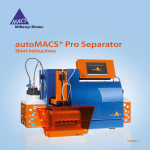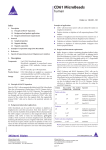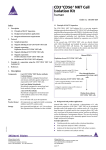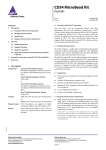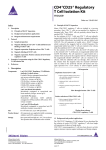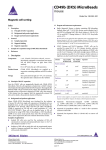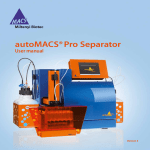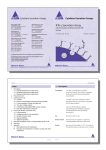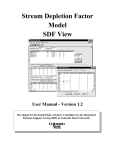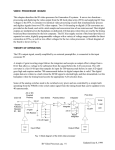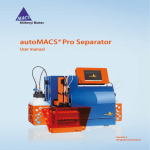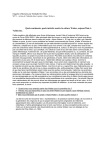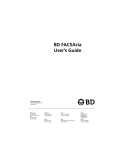Download autoMACSPro Presentation
Transcript
AutoMACS Pro Presentation Lausanne, EPFL-SV-PTECH-PTCF 9.6.2010 Alain Hirschy Application Specialist DACH [email protected] Agenda 1. 2. 3. 4. 5. 6. 7. 8. Introduction to MACS Technology Key components of the AutoMACS Pro How to work with the instrument? Software and sensors Maintenance Wear parts cleaning/exchange Rescue procedure Troubleshooting 1. Introduction to MACS Technology • MACS® MicroBeads are super-paramagnetic particles of approximately 50 nanometers in diameter, being comparable to the size of a virus. • MicroBeads do not change the scatter properties of the cell in the flow cytometer or influence the light-microscopic appearance of the cell. They form a stable colloidal suspension and do not precipitate or aggregate in magnetic fields. • MACS MicroBeads are composed of a biodegradable matrix made of iron oxide and polysaccharide. Hence, it is not necessary to detach cell-bound beads after the separation process, saving hands-on time. • Usually, MACS MicroBeads do not alter structure, function, or activity status of labeled cells, and they are not known to interfere with subsequent experiments. • The isolated cells can be used directly for subsequent studies or cell culture. 1. MACS® Technology – Benefits • MACS® Column Technology – Gentle isolation of viable, functionally active cells – Excellent purity, recovery, and viability – Flexible cell sorting strategies: • positive selection – depletion – multiparameter sorting – For virtually any cell type: more than 250 separation reagents 2. AutoMACS is Based on MACS® Technology § Automated, sensor-controlled multisample labeling with MACS® MicroBeads and subsequent cell sorting 2. Automated multisample cell sorting • MACS® MiniSampler & robotic arm • Automated labeling option • Cooling racks for 5, 15, 50 mL sample tubes • Sensor-controlled process – Choice of 12 separation programs – Automated sensor-controlled sample loading and fraction elution – Automated mandatory washing between samples – Sensor-controlled buffer supply 2. Key components (I) 1. 2. 3. 4. 5. Touchscreen Robotic arm Barcode Reader Fluid container (4) Rack detection 1 2 3 4 4 5 2. Key components (II) 1. 2. 3. 4. 5. 6. Robotic arm Uptake port / outlet port positive fraction 2 Outlet port negative fraction MiniSampler guiding 3 Memory card slot Power switch 5 1 6 4 2. Key components (III) – MACS® MiniSampler 1. 2. 3. 4. 5. Position of Cooling Tube Rack Position of Reagent Rack 4 MiniSampler socket MiniSampler lid guiding Plug connecting at the rear of the autoMACSTM Pro Separator 2 1 3 4 5 § § § Move Racks in xdirection (left-right) Direct connection to the instrument Lid for sample protection 2. Cooling Tube Racks § Cooling Tube Racks Rack type Max. no. of tubes Max. vol. Max. per sample no. of cells Chill 5 6 (5 mL) 2.5 mL 5×108 Chill 15 5 (15 mL) 12.5 mL 2.5×109 50 mL 4×109 Chill 50 3 (50 mL) § Reagent Rack 4 § Holds up to 4 vials for automated sample labeling • • • Cooling of sample and sorted fractions to sustain cell viability MiniSampler lid for sample protection Automatic recognition of different tube racks 2. MACS® Buffer • Connects directly to the instrument • Controlled for cell separation performance • High-quality ingredients Buffer Color-code Running Buffer blue Washing Solution Storage Solution* green black Order no. 130-091221 130-091222 n.a. § Three Solutions are used to operate and maintain autoMACS™ Instruments 2. Re-usable columns • For 14 days, or up to 100 separations – Special, cell-friendly matrix coating – Design: no air contact • High capacity – cell sorting within a few minutes – 105 up to 4 x 109 total nucleated cells – up to 2 x 108 magnetically labeled cells – up to 15 mL of whole blood 2. autoMACS™ Technology – Key benefits • Based on MACS® Technology, utilizes 50nm MACS® MicroBeads • Proven quality worldwide since 1999 (“classic“ autoMACSTM, 43 countries, more than 1800 Instruments sold) • Pioneer in automated cell sorting, several hundred publications in cellular research • Renowned for time-effective and easy sample sorting • Minimal operator training required, lower the workload for busy laboratories 3. Before you start • Prepare single cell suspension – Avoid cell clumps (use pre-filters) – Avoid excess of dead cells • Follow labeling instructions in datasheet – Same protocol used for manual and automated MACS® cell separation 3. How to work with the Instrument? 4. Prime autoMACSTM Pro Separator 1. Choose a cell separation approach 2. Prepare cell Sample 3. (optional) manual labeling of cell samples 5. Program a separation template (up to six samples) 6. Run autoMACSTM Pro Cell Separation 7. Run “Sleep” or “Store” program for storage 3. Choose a Separation Program Goal Strategy Program Select cell populations according to particular cell surface antigen Eliminate cell population(s), obtain 'untouched' cells Positive selection Depletion Magnetic labeling of target cells Magnetic labeling of cells other than the target cells Normal to high frequency cells Rare cells, or purity increase Normal to high antigen expression POSSEL POSSELD DEPLETE Positive selection Double positive selection, 0.5 mL Depletion Low antigen expression POSSEL_S POSSELD2 DEPLETES Double positive Sensitive positive selection selection, 2 mL * automatic Dilution 1:3 prior to uptake ** Stage loading (up to 7 mL), not applicable to autolabelling Sensitive depletion POSSELDS DEPL05 and DEPL025 Sensitive double positive selection Special sensitive depletions POSSELWB* A_Depl/A_Depls** Blood, marrow Large scale depletion 3. Priming, Rinsing and Cleaning • Priming – Program "Rinse" from Menu "Wash only" • Qrinse (Quick Rinse) – 2 min, rinse and refill with Running buffer – Standard short rinse, abundant cells • Rinse – 5 min, rinse with Washing solution; rinse and refill with Running buffer – Mandatory after sticky samples, e.g. whole blood or tissues – Recommended before rare cell isolations 4. Easy operation with intuitive software • Reagent menu—load protocol information by scanning reagents • Separation menu—program separation sequence and start process • Status menu—monitor instrument status and progress of separation • Log list menu—access process details and history • Option menu—access special programs and user settings Reagent Separation Status Log list Option 4. Bottle illumination display instrument status 5. Routine maintenance • Good sample preparation – Avoid cell clumps (use Pre-Sep filters) and excess of dead cells – Choose corect separation & wash program combination for best results • QRINSE vs. RINSE • "Rinse" recommended: before rare cell isolations, between species, sticky material, e.g whole blood, bone marrow, tissues,... • Daily Maintenance – Priming: Program "Rinse" – Shut down: Program "Sleep" for overnight storage (fill with Ethanol) 5. Periodic maintenance • Periodic Maintenance – Exchange Columns (Program "Option - Special Col_ex"): Every 14 days or after 100 separations, whichever comes first – Clean pump syringe: Every 1-2 month – Long term storage: Program "Store" (substitute columns) – Cleaning of Tubing system (also recommended for decontamination): Program "Safe", cleaning procedure with hypochlorite – MACS® Bleach solution 6. Cleaning/exchange of Wear parts • Cleaning of pump syringe (7.3.2) • Cleaning of washing station (7.3.3) • Exchange of valves (7.4.1) …are explained in details in the user manual 7. Rescue procedure • Described in User Manuel under 7.7 • • • • • • • • • • • • • • • • • • • 7.7.1 Rescue procedure A 1 Restart the instrument by switching it OFF and ON again. 2 Undo the tubing connector at the negative port and place into a 50 mL tube. 3 Take out the uptake port needle from the needle holder and place it into a 50 mL tube. 4 Undo the tubing connector of the waste tube at the waste bottle and place it into a 50 mL tube; place a second 50mL tube beside this one. 5 Run the program Qrinse. This will rinse the complete fluidic system with autoMACS Pro Running Buffer eluting the cells into the 50 mL tubes. Depending on which step of the separation program that the interruption occurred the cells will be found in any one of the vials. 6 Combine all fractions and centrifuge at 350×g for 10 minutes. 7 Discard the supernatant and apply cells to a reseparation as soon as possible. Keep cells on ice until the separation. 8 Reconnect all tubing at the appropriate positions and reposition up-take needle in needle holder 8. Troubleshooting • • • General: o What are the aim and the experiment o How often was the experiment performed before? Did it work then? • • • • • Results: o How many cells were found in the different fractions (original, positive, negative)? o What was the frequency of target cells found in the different fractions (original, positive, negative)? o Are flow data available? Which gating was performed? Where dead cells stained? • • • • • • • • Protocol: o Which sample material was used? Which species? Frozen or fresh sample? How was the sample stored prior to the separation procedure? o How was the cell suspension prepared? Was the single cell suspension checked? o Which MACS reagent was used? Was it still within the shelf life? o Which buffer was used (composition)? o Which fluorochromes were used? When was the fluorescent staining performed? o How was the magnetic labelling performed (time, temperature, amount of reagent, total labelling volume)? o Which instrument program was used? How many cells were loaded onto the column or instrument? •

























